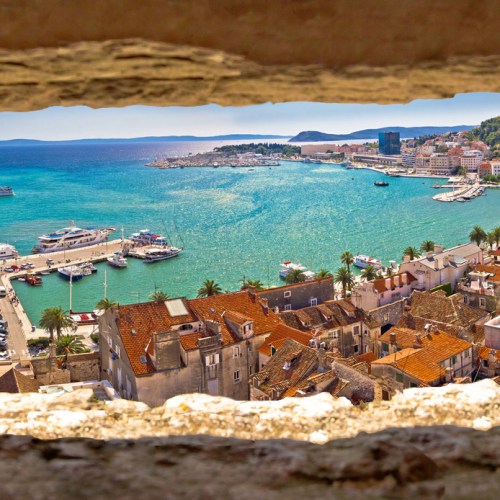
Table of Contents
We weren’t planning to stop in Ston, Croatia, but we stumbled upon this hidden gem thanks to Ivo, our thoughtful driver. He suggested a quick detour when we were leaving Mostar in Bosnia & Herzegovina en route to our final destination, Dubrovnik. The detour turned into an hour of delightful exploration, and here’s why you should add Ston to your itinerary, too:
Date of Visit: September 26, 2022

Europe's Great Wall of China
As we neared Ston on the Pelješac Peninsula, we were struck by a storybook vision of a medieval stone wall snaking up the rugged mountain behind the terracotta-roofed town. This massive wall is no prop—it’s a real-life defensive wonder built in 1358 AD. Nicknamed “Europe’s Great Wall of China,” it stretches over three miles, with remnants reaching its sister town, Mali Ston.

Ivo dropped us off so we could climb the historic ramparts and feel the weight of history beneath our feet! Unlike the sunny stock photos above there was a drizzling rain that day.
The climb is steep, and I definitely felt the weight of my feet and pounding heart, but the views are superb even on a grey day.
The wall initially stretched 4.3 miles, but pieces were hauled away by the Austrians years later, reducing its length to 3.4 miles. The wall extends from Ston to Mali Ston, a mile away.

Salty Secrets: From Fairy Tales to Fortune
Ston’s true treasure, and the reason for the wall, lies not in gold but in something even more valuable in medieval times: salt. The extensive salt pans, the oldest in Europe and still operational today, were the key to Dubrovnik’s (then called Ragusa) prosperity. The wall, along with five fortresses, was built to protect the extensive salt pans along the shores of Ston.
Remember the fairy tale “Cap o’ Rushes“? Salt was like gold back then, a food preserver and flavor enhancer. That fairy tale my mother used to read to my sister and me perfectly illustrates the importance of salt.
Cap o'Rushes

A wealthy (and vain) Englishman asked his three daughters how much they loved him. He was pleased with the platitudes from two of his daughters, but when the third said, “Why, I love you as fresh meat loves salt,” he flew into a rage and banished her for not loving him more.
It wasn’t until the father was invited to the wedding of a nobleman’s son that he realized the daughter, who loved him as much as salt, loved him the most. The mysterious bride, who was using the pseudonym Cap o’ Rushes, was none other than his daughter.
Before she revealed herself to him, she requested that the chef not salt any of the dishes at the banquet.
“I want you to dress every dish without a mite o’ salt.”
“That’ll be rare nasty,” says the cook.
“That doesn’t signify,” says she.
“Very well,” says the cook.
Cap o’Rushes father tasted dish after tasteless dish and broke down in tears at the banquet. “Now I see she loved me best of all, he blubbered.
Then, his daughter revealed herself to him, and all was forgiven.
Quotes from Cap o’Rushes translation by Joseph Jacobs. Wikisource.

A Walk Through Time: Europe's Second Planned City

Ston isn’t just about salt. Founded in 1333, Ston is Europe’s second planned city, following Carcassonne in France. Walk the charming streets and soak in the unique atmosphere of this scaled-down version of Dubrovnik.
Experience the Magic: Salt Tours, Oyster Delights, and Wine Tastings
Ston offers a feast for the senses. Learn about salt production on a tour, watching the “Watermen“ work their traditional magic. Visit the Ston Salt Works website to see a fascinating video.
Afterward, indulge in the freshest oysters from the Bay of Ston, slurped straight from street vendors in Mali Ston, or savor a delicious seafood meal overlooking the water at Restaurant Kapetanova Kuća.

No trip to Croatia is complete without wine. Luckily, Ston sits on the Pelješac Peninsula, renowned for its vineyards. Consider a Viator tour that combines Ston exploration with a wine tasting for the ultimate experience!
Ston may not have been on your original plan, but we think it’s a detour worth taking!
Viator Tours Are A Great Way to Do It All
I’m a big fan of Viator tours (a TripAdvisor company), and while we didn’t have time to take one in Ston, I researched a few that look very good. If you book one of these tours via a link below, I will get a small percentage of the proceeds.
And that my friends, will help to keep this website site up and running.

This article is the 17th in my 19-part Balkan series, which began with ‘Road Tripping on the Balkan Peninsula’ in September 2023. There, you will find our itinerary to help you plan your trip.
- Ratings are based on 1) Natural Beauty 2) Unique Activities 3) Old World Charm














5 Comments
I loved Ston and wish I could have stayed there longer!
I just read your piece about wine-tasting and oyster-sampling on the Peljesac Peninsula. Lucky you, you did it right! I would have loved to have had time to savor the area.
You entice me to visit Croatia with this post. I missed it last time I was in Europe. Thanks for sharing this fascinating town.
Thank you for taking the time to read my post on Ston. I think you will fall in love with Croatia! There is so much beauty and history in the Balkans. And by the way, I’m so glad I stumbled on your blog. I enjoyed reading a few of your posts. I can’t tell you how impressed I am that you wrote the one on Helsinki as a stream of consciousness exercise. I am looking forward to reading your future posts on “Something To Ponder About.”
Thank you for your kind words about my writing. I loved Helsinki and I think travelling solo enhances my memory so that the words just tumbled out. I may have edited one or two but largely the writing just flowed that day!
Discover more from Travel The Four Corners
Subscribe now to keep reading and get access to the full archive.
Continue reading